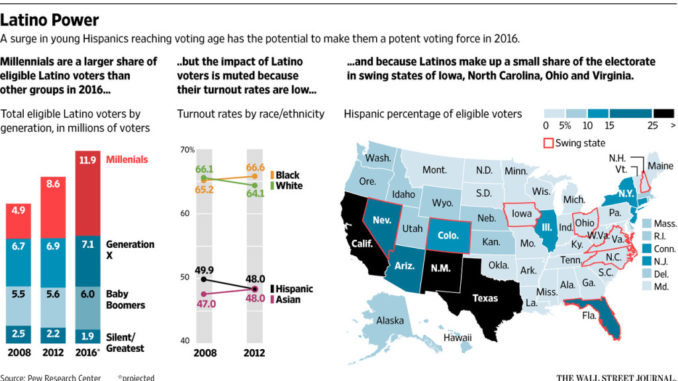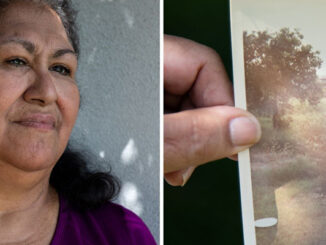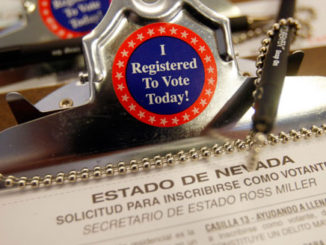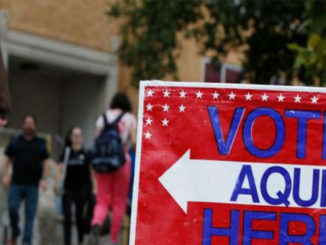
by Janet Adamy , WSJ
Hispanic millennials will account for 44% of record Latino voting bloc for 2016, Pew study says
A surge in voting-age Latinos since 2012 is prompting both political parties to craft youthful appeals in Nevada and other key swing states.
A Pew Research Center study released Tuesday shows that millennials born in 1981 or later will account for 44% of the record 27.3 million eligible Latino voters projected for 2016, up from 37% in 2012. That means the Hispanic electorate will skew younger than the voting pools of whites, blacks and Asians.
Most of the growth comes from a boom in U.S.-born Hispanics reaching voting age, with about 3.2 million Latinos who are U.S. citizens crossing the age 18 threshold between 2012 and November 2016. Adult Hispanic immigrants who gained citizenship accounted for a smaller share of new voters with a gain of 1.2 million since 2012.
The findings underscore broader changes in the ethnic makeup of the U.S. electorate that could influence the outcome of the 2016 presidential election. Projected to make up 11.9% of eligible voters, Hispanics will be nearly as big a force in 2016 as black voters are at 12.4%, Pew found.
Hispanics have voted heavily Democratic in recent elections. In 2014, they backed Democrats over Republicans in congressional races 62% to 36%, according to Pew. Officials at the Democratic National Committee point to derogatory comments Republican presidential candidate Donald Trump has made about Mexicans to argue that GOP support among Hispanics could slip still lower.
Ruth Guerra, the Republican National Committee’s director of Hispanic media, disagreed, saying: “The Hispanic community is not a monolith.”
Young Hispanics’ influence at the polls will be muted if they follow recent history and vote at lower rates than most other groups. In 2012, 37.8% of Latino millennials eligible to vote said they cast ballots, compared with a voting rate of 61.8% for the overall population of eligible voters.
Advocates and researchers say this voting apathy stems in part from their high concentration in California and Texas, neither of which are swing states. “These places just don’t get the same attention from candidates and campaigns as you would in a state like Florida,” said Mark Hugo Lopez, director of Hispanic research at Pew, which is nonpartisan.
click on image to enlarge
Among the swing states seeing the swiftest Latino voter growth is Nevada, where the percentage of Hispanic eligible voters has risen 70% since 2008, Pew found. That’s the highest increase of the six states where Hispanics make up at least 15% of eligible voters.
Both parties have zeroed in on the state as the place to go after young Latinos. This week, the DNC plans to hold a mock caucus training session in Spanish in preparation for Nevada’s caucus next month. The state arm of the Democratic Party is working to translate its website into Spanish, said Eric Walker, a DNC press secretary.
The DNC said the GOP presidential candidates’ tough stances on immigration, coupled with Mr. Trump’s anti-Mexican rhetoric, may be the most potent force behind Latino participation in this year’s elections.
“Donald Trump is the best recruiter we have in terms of getting Latino voters registered and out to the polls,” Mr. Walker said.
Republicans say that jobs and education resonate more strongly with young Latinos than does immigration. As part of a nearly $300,000 advertising campaign, the RNC last week aired the story of Mario Ruiz, a 22-year-old from Pueblo, Colo., whose fingers grace a music-mixing machine while he proudly explains he’s the first in his family to graduate college.
The National Association of Latino Elected and Appointed Officials Educational Fund, a nonpartisan group, plans for the first time to use a text message campaign to reach millennial Latinos with reminders to register to vote and with surveys after debates this year. Past tactics, such as voter-registration drives at high schools, were fruitful but cost too much money, said Paula Valle, communications director for the group.




